#singers from xxi century
Text

alexandra savior promoting her first record belladonna of sadness
#alexandra savior#savior alexandra#singer#female singer#singers from xxi century#singers#alsavior#asavior#asavioredit#alexandrasavioredit#alexandrasavior#lanadelrey#lana del rey vibes#she doesnt sound at all like lana tho#grl pwr#pwr grl music#spooky#girls#girlie#audeline#frankie#mirage#the archer#sad girl music#vintage#obsessed#coquette#bad ass bitch music#badass#80
0 notes
Text
I just realized one thing. When Marius took Amadeo back to Kiev (I know the modern spelling is "Kyiv", but I'll use the spelling Anne Rice used in her works while speaking of XV century, OK?), he was uncertain whether Amadeo will visit and come back to Venice, or... you know... whether he will see Kiev and decide to stay. Still, he agreed immediately. I feel feelings.

Other notes on Amadeo's journey to his homeland:
Maybe Amadeo was really supposed to remain small even if he wasn't turned in his teens - his mother was a small woman.
And he probably has her eyes, because Ivan's eyes were blue, but brown eyes are a dominant trait, at least one of Andrei's parents should have had brown eyes.
It saddens me that his mother remained a nameless character. Just like Lestat's father, but, unlike Lestat's father, she did not deserve it.
Andrei had elder sisters - one of them got married while he still lived with his family. And there was another sister, Anya, who became a woman while he was away (at first he mistook her for his mother), but for some reason she still lived in their father's home...
And there was Andrei's uncle Borys, a good singer, young enough to be his brother, but already as big as Ivan. Well. Maybe Amadeo was supposed to remain small. We'll never know!
It's sadly ironic that Ivan lived the rest of his life firmly believing he DID save his son from the horrors of religion. (And yes, I agree, he is such an underappreciated character!)
Also, when Amadeo left his family, he promised this time he would write. A promise he could not keep, as we all know.
One thing I totally agree with - NO ONE should live in a place with long winters. *looks out of the window with disgust and despair*
Also. The description of ruined Kiev hurts in a very specific way - like, you open a book to escape from reality but reality catches up with you. Ruined Kiev in XV century and Kyiv under fire in XXI. Forget vampires, something I think we humans are the worst evil.
(Sorry for being bitter, it will happen again.)
57 notes
·
View notes
Text

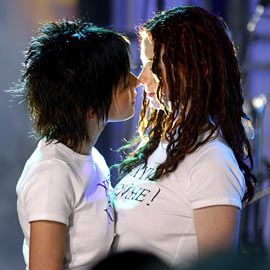
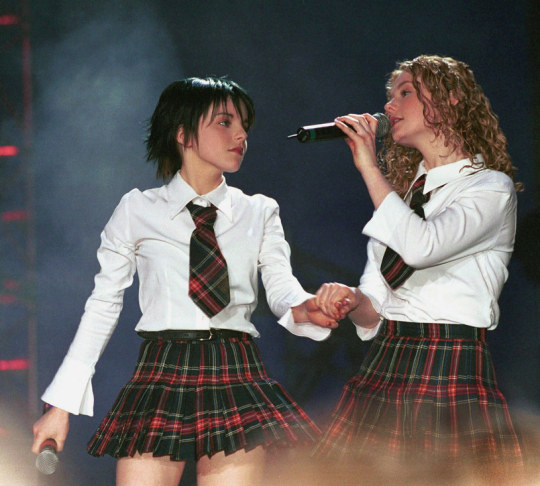
t.A.T.u (Russian: Тату) — Russian music duo formed in 1999 that consist Julia Volkova and Lena Katina. Lena Katina first music steps were taken in children's music pop band Avenue, in 1997 she joined Neposedy, later on, Julia Volkova also joined the formation (They were part of the band along with members like Sergey Lazarev and Vlad Tapalov). In 1998 Julia got kicked out of the band for bad behaviour, smoking cigarettes, drinking alcohol and getting in arguments with other band members, but Neposedy denied it and said that Julia left the band because of her age (Neposedy were children formation while Julia was 12 when joined the band) Lena left the band in 1999. Same year Ivan Shapovalov and his business partner Aleksander Voitinskiy planned to start a music project in Russia. They started organizing auditions in Moscow in early 1999 for teenage female vocalist. By the end of auditioning, the partners narrowed their search down to ten girls, including Lena and Julia that finally became the members of t.A.T.u. Lena and Julia knew each other before the auditions. Both girls stood out among the others because of their appearance and vocal experience, but the producers decided to start working with Lena. Katina began recording demos, including "Yugoslavia", a protest song about NATO boming of Yugoslavia, when the demos were cut, Shapovalov insisted that the project needs another girl, that will be a complete opposite of Lena. In late 1999 Julia Volkova was added to the project to complete the duo. Shapalov after adding Volkova to the project, noticed how close the girls are, he decided to use it and gave the band lesbian image, which made Voitinsky left the band because he said that the idea was immoral and he doesn't want to be part lf it.
"Ivan said, that we need second girl in a band, and that the band needs to be famous, He just said, that we need another girl, because if we will have two it will be happier and more interesting, we can take someone new, someone different, and then they will be singing together. Now i am working in a new project, not in Ivan project, he was a horrible collaborator (...)"
- Aleksander Voitinskiy for programme "Show-Business", 2000
According to Katina, Shapovalov was inspired to create the duo after the release of the Swedish film "Show me love" about romance between two school girls. After completing the duo producers decided to name the group word Тату (Tatu) It is a shortened version of russian phrase "Та любит Ту" (Ta lyubit tu — eng. This [girl] loves that [girl]) For the whole year girls were recording songs for their first album collaborating with Elena Kiper.
Debuted in 2000 with their single "Ya soshla s uma" The song describes the pain in a girl's soul because she is in love with another girl, but is afraid. It became a big hit in Central-Eastern Europe just like their next singles — "Nas ne dogoniat" and "30 minut". Their debut album "200 po Vstrechnoy" came out in May 2001, the english version of the album "200 km/h in the Wrong Lane" came out in 2002, the album was certified platinium by IFPI for over 1 milion copies sold in Europe and become the first foreign group to reach number 1 in Japan, it was also certified gold in United States. "All the thing she said" (english version of their song "Ya soshla s uma") have made it to first place of top songs in over 20 countries, and have been sold in 6 milion copies, it became one of the most succesful singles of XXI century. The controversial music video showing Julia Volkova and Lena Katina passionately kissing in rain infront of a crowd dressed in Catholic school uniforms was supposed to show — Created by their Manager Iwan Shapovalov — "love" between singers. Later on, t.A.T.u relased 3 english albums and 3 russian albums.
t.A.T.u scene image was controversial since beggining. They are most known from their first album, which was revolving around homosexual relations between Julia and Lena. During the promotion of second album they admitted that it all was just a marketing strategy, and they are not lesbians. Even after that they didn't give up on their homosexual characters. Lena Katina spoke up about it in one of their interviews in 2009
"Julia had some lesbian experiences before t.A.T.u, and i didn't, so it was obvious i was quite embarrased, it was foreign to me, but i agreed because i knew this topic is really important. I was on a meeting with fans in Los Angeles and alot of people are still greatful for us. One girl told me that t.A.T.u is the reason why she survived. It's a horrible feeling when you're a teenager and you know that you aren't like others. All your best friends are falling for boys, and you want a girl. You feel alone, and no one understands you, and then a band shows up and tells you that everything can happend in life and you shouldn't be afraid of who you are. When people are saying, we saved them from suicide, i feel like it wasn't pointless. (....) We are also actors somehow. We created a story of two girls in love, and we played it."
Their second album was about interpersonal problems, the russian title (Ludi Invalidy) itself was already controversial around organisations fighting for rights of disabled people. In their opinion the title was suggesting thath disables people don't live, they funcionate, and their only personality traits is stupidity, brutality and greed. Lena and Julia disagreed with organisations and said that they don't understans the point of singles name and the meaning behind it.
Their last pair of albums "Vesyolye Ubylki" and "Wasted Managment" was relased between 2008 and 2009. T.A.T.u oficially broke up in 2011, but they reunited to preform at special ocassions as The opening ceremony of the 2014 Winter Olympics in Sochi.
(It's my first longer post in here, sometimes inbetween of weird images i want to be posting some more productive stuff about topics that i find interesting, i will be posting more about my fav bands, i wanted to make more posts today but this one took me waaaayyy too much time. If u know anything else that you would like to add to this post, or correct me on my mistakes, feel free to comment :P)
#queer community#lgbtqia#lgbtq#early 2000s#2000s#nostalgiacore#nostalgia#music#2000s music#electropop#t.a.t.u.#russian music#2000s pop#im so scared#pop music
15 notes
·
View notes
Text
Jungkook Series (XXI)
* ² - two shots s - contains smut
Maniac ² by @strawbearytae exes to lovers, college au
Summary: A mutual breakup from your long term boyfriend leaves you inevitably devastated, but a unexpected collaboration may just be the breakthrough the two of you needed.
Rebound by @yoongiofmine s strangers to lovers, rockband au
Summary: After being dumped by your boyfriend of three years, your best friends decide the best way to get over someone is getting under someone else. A dingy dive bar in the middle of nowhere is the perfect place to find a rebound. But what happens when you end up on the bed of a punk-rock lead singer who can’t seem to get enough of you?
Triptych: Shape of Love by @myooniverse s architect!Jungkook, architect!Taehyung, friends to lovers, FWB, love triangle au
Summary: You are madly in love with him, but he has eyes for another. So what do you do when the one you love doesn’t love you back? Like any logical person, you sleep with your best friend as a distraction. As the lines between the three of you begin to blur, your messy triangle obscures everything around you, even the shape of love.
Make You Mine ² by @colormepurplex2 s enemies to lovers, A/B/O au
Summary: Alphas might rule the world, but Jungkook finds himself being ruled by the need to make you his.Omegas are rare, precious, and pliant. At least, most are. When you present late, well into your twenties, you’re already set in your headstrong ways; a challenge even for a commanding alpha like Jungkook. Add to that the centuries-long feud between your families and the last thing anyone expected was for him to claim you as his soulmate.
Blackout by @jjungxkook s friends to lovers, college au, roommates au
Summary: Utility bills shooting up like this should be an international crime. Luckily, Jungkook has the perfect idea(s) to save up money and make your night sinfully unforgettable.
34 notes
·
View notes
Text




Unforgettable moments #fashionreminder: singer Natalia Przybysz, formerly known as NATU from #Sistars
wearing HOP SA SA by paulina palian
currently collection instagram: @paulinapaliancollection
About the collection see fb HOPSASA.by.paulina.palian
graduate collection 2008 inspired by Polish Folk and contemporary street fashion of the beginning of the XXI century
About the Artist:
Natu, Natalia Przybysz, also known as Natu or N'Talia, is a Polish rhythm and blues singer.
She is a member of the Polish Society of the Phonographic Industry. via Wikipedia
#NataliaPrzybysz #natu #PolishFolk #folkmania #sztukakobiet #polipalian @palian.art
pics from http://muzyka.wp.pl/gid,608086,page,2,title,Natu-w-Warszawie,galeria.html
3 notes
·
View notes
Note
What do you think about the lack of jimin lines in bts recent songs? I know they said “the members distribute the lines between them” but do the members really think he shouldn’t be given more that 2 lines? Or is it the company’s decision? I wanna be excited for the new collab but i’m 90% sure he will have the least amount of lines
I honestly haven't been excited about any BTS release after being so disastrously disappointed with butter so I'm not expecting anything from this song either, yet.
I don't believe that BTS themselves decide the line distribution, that's definitely not the whole truth. They couldn't even actually decide on what pitch it was more comfortable for them to sing in, like...... Please.
It seems plausible that they all sing the entire song and then the line distribution is ultimately decided by the music engineers and they record the final version of the song according to that. It's definitely the company's decision, in the end. I believe BTS have input, that they express their opinions and doubts and the company takes them into account, but it's just that, opinions. The last word will always be the company's. The members are NOT distributing the lines themselves by any means lmao. Anyone who's ever been a fan of a group in the XXI century knows that labels take the absolute lead in these decisions.
Something that doesn't make sense to me is, why are they changing up their voices so so so much with autotune to make them sound higher and more similar to Jimin, instead of.. simply having Jimin sing more?

Everyone must've noticed how Jin, Jungkook and Taehyung don't actually sound like themselves in any song released after 2019. All their voices have been accommodated to a higher pitch, sounding robotic and devoid of actual color and personality. You don't understand the relief I felt listening to with you for the first time, no oversaturated autotune and metallic sounds, just voices. Or a while ago, when I was listening to outro: love is not over and I mentioned too how Jungkook's voice sounds so much richer and mature in that track, compared to the ones BTS release now.
Absolutely no bad feelings for rapline but don't make the rappers sing???????????????(-_35+&":!(!_#+)! How is the lead singer getting his lines cut so the rappers get their shot at (bad) singing. Be serious.
Me to me: don't complain so much
Also me: they're doing everything wrong!!!!

Hybe's people are lazy and unprofessional. They seem unable to find a middle ground and it shows that nobody knows anymore what is BTS and what type of music they do. It wasn't only noticeable on the performances or MVs, it was noticeable in all aspects of the production of their music, too. Line distribution included. For a lot of their latest songs I'd say they didn't even know what they were doing. I hate the vocal arrangement in PTD. It's just awful. Don't even get me started on my universe tho I'm not sure if I should blame hybe or Coldplay for that.
9 notes
·
View notes
Text
When life gives you lemons...
Since we are in the XXI century, Beyoncé has always been on the scene. She was first part of a famous R&B group of singers, Destiny’s Child, and she is the only one of them that keeps on succeding even though the group disolved on 2006. She’s been making hit after hit since then, some of them with her partner, the rapper Jay-Z. They’ve been on a relationship since almost the beggining of the 00’s, they also got married and even had a child. Nonetheless, this doesn’t mean this is a happy story, I say this because they have gone through hard times together and I want to adress a specific moment in their relationship.
It turns out that around 2014-2015 Jay-Z cheated on Beyoncé…but it wasn’t the end of them, they forgave each other and they coped in they’re own ways. In her case, she made a masterpiece of an album: Lemonade.
Each song of Lemonade (except for Formation, which is the only single of the album and is not part of the story) is a part of her story, going through every emotion she felt and ending with forgiveness.
This album is also a visual album, which means the story is also told with a cinematic experience. It starts with “Pray you catch me” => Chapter 1: Intuition. After this Bey goes through denial, anger, apathy, emptiness, accountability, reformation and forgiveness, in that order and each corresponding to a specific song. This feeling are followed by resurrrection, hope and, finally, redemption associated with “All night”, a song about loving each other…all night long.
This is THE conceptual album by Beyoncé because of the story telling, the mix of sounds going from reggae, blues gospel, through hip hop, rock an even going to country music. She is clearly one of the most influential artists of our generation and I find very impressive that she was capable of transforming such a negative experience as the infidelity of your longterm partner into such a complete and majestic album. In a way, life gave her lemons and she made…Lemonade.
David Garrido Vásquez
0 notes
Text
“History’s about to get overthrown“
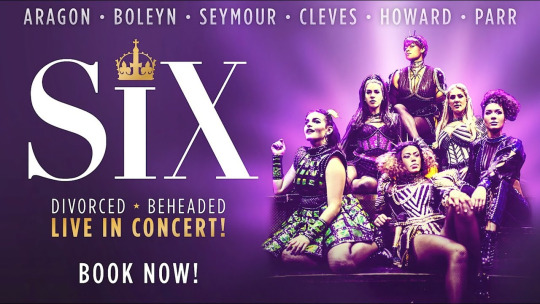
Trailer of the show
Today I am going to talk about a recent musical, that became quite popular in only 2 years: Six the musical.
The songs are performed by “the 6 wives“ of Henry the VIII, each of them sings her biography and her point of view of her relation with their common husband. The show isn’t as long as a regular show on Broadway, because it is more like a concert than a Musical. It was written by Toby Marlow and Lucy Moss, and premiered in Edinburg in 2017. Since then, the show went from Scotland to London, and was to premiere on Broadway 6 months ago (but thanks to Covid19, it didn’t).
Like for Hamilton, the producers and the performers are part of the new generation; they took the risk to present something new, and it worked.
As I said, it’s more of a concert than a musical. The songs are pop and catchy. The singers are like rockstars on stage. It’s a whole performance, the costumes imitate the one that iconic divas from the XXIs century wear during their concerts.
The band is only composed by women, and “the queens“ are portrayed by different kind of profile (for exemple Catherine Parr, Anne of Cleves and Catherine of Aragon are black).
There is a lot to say about this show but I am going to talk about one major event linked to this musical. On the 31 August 2019, the cast organized a flashmob in front of the Tower of London.
A large amount of people were reunited to share this moment, the performers themselves were there. The fact that people answered to the call, testifies how an audience can influence the impact of a movement.
I am talking about “movement“ because this flashmob was not that innocent. When you look at the context it’s a bunch of people singing and dancing over a song that critics the British monarchy, at the location were some of those wives have been executed (Anne Boleyn and Katherine Howard). The aim of that musical, is to point the maltreatment of the women in court. It gives a “voice“ to those women, who have been lost in history. People remember them as the wives of Henry the VIII and that’s all. We have an other version of History, and we learn a bit more about them. They finally have the tribute that they deserved.
A flashmob doesn’t seem like such a tribute, but the message from that musical, is to tell that in history and in the royal family, women aren’t respected and that it is still the case today. Elizabeth II’s jewelry is in the Tower of London, bringing this crowd together in front of it, is highly symbolic. Because it’s like if the song was addressed to the Queen and the whole monarchical system.
Video of the flash mob
Favorite songs:
Ex Wives
No Way
Don’t Lose Ur Head
14 notes
·
View notes
Photo

A Great Catch: The 153 Fish
“I welcome you on the eve of a great battle.” So began General Dwight D. Eisenhower on May 15, 1944, solemnly addressing the admirals and generals and officers of the Allied Expeditionary Force, announcing the proposed strategy for Operation Overlord, codename for the Normandy invasion. Underestimated as an orator, Eisenhower’s speech riveted the attention of all in the tense atmosphere. The location was an unlikely one: a lecture hall of Saint Paul’s School in London. The boys had already been evacuated to Berkshire during the Blitz. The top brass, who had arrived from the advance command post of the Supreme Headquarters of the Allied Forces at Southwick House in Hampshire, were seated on school chairs, with two armchairs occupied by King George VI and Prime Minister Winston Churchill. General Bernard Montgomery, the future Field Marshall, brought out his maps to show the British and American positions. The school served as headquarters of the XXI Army Group under Montgomery, and he felt at home there because he was an Old Pauline. Planning took place in the office of his old Headmaster, or High Master, which was the title used from the day of the school’s foundation in 1509 by John Colet.
As a close friend of Erasmus, and an even closer spiritual advisor to Thomas More, Colet was the epitome of a Renaissance humanist, laden with learning he had brought back from France and Italy for lectures in his own university at Oxford. More lured him back to his birthplace of London where his father had been a rich merchant and twice Lord Mayor. As Dean of Saint Paul’s cathedral, Colet put his reforming principles to work with eloquent imprecations against the pride, concupiscence, covetousness, and worldly absorptions that had tainted the priesthood. Archbishop Warham of Canterbury dismissed frivolous charges of heresy brought against Colet by offended clerics. Colet’s combination of charm and audacity engendered the respect even of Henry VIII, despite his bold preaching against the king’s French wars. As a priest with no children of his own, and no nieces or nephews because all twenty-two of his siblings had died in childhood, Colet devoted much of his inherited fortune to founding Saint Paul’s school for teaching 153 boys literature, manners, and, with Renaissance flair, Greek on a par with Latin. Erasmus said that when Colet lectured he thought he was hearing a second Plato. If so, his Platonism was Christian. He wanted a great catch, similar to the 153 fish that the apostles had hauled in at the command of the Risen Christ. The boys would be welcome “from all nations and countries indifferently.”
The catch was great indeed, and since then the school has turned out graduates including, just for starters: John Milton, Samuel Pepys, John Churchill, G.K. Chesterton, three holders of the Victoria Cross, and the astronomer for whom Halley’s comet is named — all rising from the first 153.
Exegetes, sometimes with too much time on their hands, and even earnest saints, have teased 153 and other numbers into signifying possibly more than their meaning. Jerome tried to find some significance in the fact that the second-century Greco-Roman poet Oppian listed 153 species of fish in his 3,500 verses about fishing, the “Halieutica,” dedicated rather sycophantically to the emperor Marcus Aurelius and his son Commodus. Of course, Oppian was wrong in his counting; besides, he wrote after the compilation of the Gospel. Augustine found that 153 is the sum if the first seventeen integers, which may reveal nothing more than his skill at arithmetic. In his devotion to the Rosary, Louis de Montfort found something prophetic between the catch of Galilean fish and the sum of fifteen decades of Hail Mary’s plus the first three beads.
There may be no end to such agile mental exercises, and I once wrote a book — Coincidentally — rather whimsically illustrating how it is possible to detect endless matrices if you try hard enough. For example, faddish New Age fascination with the esoteric numerology of Kabbalah cultism can strain minds. It may not have been a helpful influence on the popular singer who gave millions of dollars to a Kabbalah institute and recently was confined to a mental health facility purportedly against her will. Carl Jung wrote at some length about what he termed “synchronicity” and warned that an obsession with “acausal principles” could unbalance reason. Yet even a detached observer might pause at the fact that the Sacred Tetragrammaton appears 153 times in Genesis.
The point here is that there are many levels of meaning in divine revelation that may be clues to the operation of Divine Providence. “For I know the plans that I have for you, plans for welfare and not for calamity to give you a future and a hope” (Jer. 29:11). Even our limited mathematics may articulate something of the symmetry by which the pulse of Creation may be taken: “‘To whom then will you compare Me, or who is My equal?’ says the Holy One. Lift up your eyes on high, and behold who has created these things, who brings out their host by number” (Is. 40:25). Perception of this saves the saints from madness and inspires them to awe.
Contemplation of the unity of the True God and True Man encounters layers of reality beyond the comprehension of human intelligence. Nonetheless, we can perceive the existence of those dimensions. A “Participatory Anthropic Principle,” first forwarded by John A. Wheeler, suggests that the universe is structured with a set of physical constants or “cosmic coincidences” without which there would be no intelligent life on Earth, and that it is only by participating in that structure by rational perception that the constants or coincidences have their potency. So there may be in those 153 fish the Voice saying: “I have yet many things to say to you, but you cannot bear them now” (John 16:12).
It would be a mistake to suppose that the apostles went back to fishing in disobedience to the Master’s command years before that they drop their nets and follow him. Christ is the Alpha and Omega, meaning that he is able to know everything from start to finish at the same time. Before the Resurrection, Jesus told the apostles that they would meet a man in Jerusalem carrying a pitcher of water, from whom they would rent an Upper Room: “So they went and found it just as Jesus had told them (Luke 22:13).” Thus he was also able to “set up” his men, ordering them to go to the Sea of Tiberius, knowing what he had prepared for them there, in order to instruct them.
In his humanity he did a domestic thing in cooking breakfast. In his divinity he predicted what the apostles would become. Whatever else may be encoded in the number 153, the fact is that this event happened, for had it been an oriental myth there would have been a million fish. This number was a detail never to be forgotten. Even when the youngest of them, the cadet of the Twelve, was the last to survive and his mind was weary with age, he said with a thrill like that of a youth: “That which was from the beginning, which we have heard, which we have seen with our eyes, which we have looked upon, and our hands have handled, of the Word of life” (1 John 1:1).
There is one thing we know that prevents miniaturizing Christ as the best of men but only a man: “For in Him all things were created, things in heaven and on earth, visible and invisible, whether thrones or dominions or rulers or authorities. All things were created through Him and for Him. He is before all things, and in Him all things hold together” (I Col. 16-17). In him was an urgent appeal to the intellect, which for the Jew was a function of love and not confined to the brain, as is clear in the Resurrection appearance to Cleopas and his companion on the Emmaus road: “O foolish ones, how slow are your hearts to believe all that the prophets have spoken. Did not the Messiah have to suffer these things and then enter his glory?” (Luke 24:25-26). Here was the culmination of his earlier rabbinical catechesis: “‘Do you have eyes but fail to see, and ears but fail to hear? And don’t you remember? When I broke the five loaves for the five thousand, how many basketfuls of pieces did you pick up?’ ‘Twelve,’ they replied. ‘And when I broke the seven loaves for the four thousand, how many basketfuls of pieces did you pick up?’ They answered, ‘Seven.’ He said to them, ‘Do you still not understand?’” (Mark 8: 18–21).
The unseen calculus that fascinated Oppian when counting fish in coastal Cilicia much more amazed William Blake when describing an imagined “Tyger” which certainly was not rampant in London: “What immortal hand or eye / Could frame thy fearful symmetry?” If there is substance to some anthropic principle in the play of numbers, it is found in the fact that after the 153 fish had been dragged to shore, a small fire was burning as Jesus asked Peter three times if he loved him. And Peter wept in remembering that by another small fire in Jerusalem he had said three times that he never knew the Man.
BY: FR. GEORGE W. RUTLER
From: www.pamphletstoinspire.com
1 note
·
View note
Text
USING TAROT TO SELF-INVESTIGATE
Taking a Candle into Your Subconscious Mind
by Azrael Encarnacion
At the end of 2016, I began gaining interest in numerology. Despite having received a book on the subject a few years back, it wasn’t until a friend suggested I try a free online numerology report, that it clicked. By “clicking” what I mean is I have a color-coded spreadsheet in my Google Docs for numerological entries I’ve since obsessively collected. We can talk about that another time.
Researching the meaning of numbers though, I soon discovered they were just as an important part of the Tarot as the illustrated images. Each card being numbered, they followed an ascending story or spiritual journey based on the principles of numerology.
What little I knew of numerology back then, I knew even less about Tarot. However, I was curious enough to purchase a deck and stare them down for a week or two before I began to shuffle and draw cards to do readings on myself. All in all, what I found was a tool, much like a morning mirror to check in with. To see where I am and what’s happening on the surface and how it correlates on a deeper level with what’s happening on the inside.
At first, the cards can definitely seem intimidating. They’ve been around since at least the 15th Century, then known in Italy simply as playing cards called “Trionfi,” (Triumph of Trump). But unlike normal playing decks we still use today for Poker or Spades with 52-54 cards, the Trionfi set was a little different.
What set them apart were the additional 22 cards that made up the trump suit. These are the Major Arcana of the Tarot, beginning with 0 / The Fool and ending with XXI / The World (some decks begin with I / The Magician and end with XXII / The Fool).
The remaining 56 cards, or Minor Arcana, are made up of the 4 suits: Chalices, Wands, Pentacles, and Swords. Each suit has 14 cards, consisting of 10 pip cards (1-10) and 4 face cards (King, Queen, Knight, and Page). That’s 78 cards in total! And every one of those cards has its individual meaning which can alternate depending what it’s paired with and on what side it’s drawn (right side up or reversed). It can seem like a comprehensive nightmare but in all honesty, what I’ve realized to be the most difficult part of the Tarot, is explaining how it works to others.
This is because there is no definite right way. Obviously, the cards can be used to play a game. At one point it was the most popular card game in all Europe, which to me, knowing only the divinatory tarot, sounds hella weird--Like using UNO cards in a fortune reading (to which a “draw four” would fuck my whole day up).
In terms of divination, the Tarot exercises our intuition, which is based on our individual experiences. Certain imagery engages us in unique ways, much like a rorschach test with ink blots, prompting associations from our subconscious mind. Cards will mean different things to us individually. Likewise, we’ll have our own preferences for how to spread the drawn cards and why to pull them in the first place.
Some people pull or have cards read for them to gain insight on the future and how best to prepare for it. Others do so to take inventory of their present actions and thoughts + how to maintain life at their best vibration. There’s all sorts of reasons but what’s at the core here?
I asked my homegirl, Lucia, a licensed massage therapist currently living in Tampa, FL, who’s used Tarot cards longer than I have (she was the one who gave me that numerology book) and she put it perfectly. “It’s just like using a candle in a dim room--We already know what we’re looking for in there, it’s just not well lit.”
Lucia uses the Tarot to bring more clarity and detail to her predictions/intuitions. She feels the imagery along with the numbers and other symbolism help set a story to her feelings or abstract ideas.
Yes, clarity! Whether you’re looking at the future, the present, your relationships, career, etc. Tarot readings provide a clarity through the metaphorical narrative found in the interpretations and their relevant connection to our lives. It gives us a deeper exploration we normally wouldn’t pursue. The Tarot tilts the angle, tricks our mind to give up information possibly because of its inherent game-like nature.
Divination comes from the random cards that are drawn. The selection is served to us by the universe. You can put as much weight on that as you’d like but the fact remains, by revisiting your thoughts under the story told by the cards, we investigate ourselves thoroughly and thus arrive at deeper revelations.
Also in Florida, my other homie, artist/graphic designer, Nia Perry, who illustrated her own deck to further personalize her readings, told me the universe communicates with us via sound, imagery, and feeling. She views her “Self” as a fragment of that higher intelligence. “My use of Tarot stems from my belief that the universe is intelligent and has a larger perspective of time and space than I ever could.” This perspective offers clarity when our five senses can go no further. Again clarity!
But Nia reminds me of the idea that our subconsciousness is part of that bigger entity. It’s the channel that’s forever tuned in regardless if, on the surface, we’re not. The subconscious absorbs more information, it acts without our permission, sometimes to our regretful detriment. An active relationship with our subconscious mind is an active relationship with that channel through which the universe has direct access.
I use the Tarot to tap into that channel. It’s already in my mind but as Lucia stated, it’s in a dark room for which a candle is helpful. Will I always need a candle for that room? Maybe not, but Life’s journey, for me, is one that takes you from new room to new room. Its that Radiohead music video for Daydreaming, in which lead singer, Thom Yorke walks through door after door.
In addition to clarity and universal alignment, what’s perhaps most engaging for me about the Tarot and why it works as an effective self-maintenance tool to guide my conscious mind toward balance is the fact that it requires creativity. I get so wrapped up in figuring out the “jigsaw puzzle” that I forget the completed picture is a self portrait. One that indeed resonates + makes me check certain behaviors or offer more energy where it’s needed.
Imagine playing Connect Four and when the game ends you realize, as you were trying to connect those four discs, the activity helped you ruminate on current ideas, events and relationships in your life. And perhaps helped you think up creative solutions to any worries concerning them--Imagine if the only reason you did so just then, is because you thought you were just playing Connect Four and didn’t think shit would get this real!
That said, I wouldn’t know how to tell you when and how you should incorporate Tarot in your life. It could very well not be for you. You could have that same self-discourse via dreams or certain types of meditation, therapy, journal writing, or fuck it maybe even Connect Four!
What’s important is you do check in from time to time to see how you’re doing. Especially if you sense self-sabotage or a disconnect between your thoughts and your actions. How can you be you if so much is happening on autopilot, informed by a secret room your conscious mind is not permitted entrance to. Your most primal of emotions operate at a level similar to extreme sound frequencies, too low or high for the human ear to register but they still affect the air--Likewise, these emotions still affect our inner space, influencing actions on the outside.
If you’re curious about Tarot cards as I was and are wondering if you should get your hands on a deck My reply is that you’ve already answered your own question. There’s no wrong way to start and despite the different decks, spreads, tutorials, testimonials, etc. the one thing necessary is your intuition and an open mind.
#yoursnotyours#azraelencarnacion#tarotcards#divination#spirituality#selfdevelopment#intuitiveintrospection#psychology#psychoanalysis
1 note
·
View note
Text
Answering some unasked Sera Myu questions
…I know, no one actually tagged me or asked to do this meme, but @sailorzakuro invited anyone who wants to take part in this challenge and I’m very eager to, so let’s start!
1) You are a Myu fan since…?
Short answer: since 2012, aged 13. Long answer (beware, when I say long, I mean very long): you can find a fully detailed axplanation of how I got into Myu somewhere in this post, in the second reblog https://usaghinanami99.tumblr.com/post/170867407508/myucornerorg-usaghinanami99-myucornerorg
2) The first musical you saw?
I always watch and read things in strict chronological order, so that was Gaiden. I think you can see how I went on.
3) Your favourite musical?
OMG Eien Densetsu Kaiteban is the best musical ever, it’s got such a great soundtrack and the Senshuraku recording is especially touching!
4) Your favourite Sailor Moon actress?
QUEEN ANZA FOR LIFE!!!!111!!1
5) Say one positive thing about every Moon actress.
Anza: OMG QUEEN I mean: best singer, best actress, best everything… Should I really go on?
Fumina: A nice singer and perfectly in-character for a post-manga Usaghi, very calm and compassed compared to others.
Miyuki: If there is a queen in Myu (see before), then Miyuki is the princess, she’s so good at everything she does and I love her dearly… and of course I miss her so much! ;( She’s just so skilled that I think of her as a performer who would definitely deserve to be #1, if only there weren’t someone who is even better… this is without diminishing Miyuki’s ability at all! Plus, she’s the one who made me undestand that nasal voices aren’t necessarily terrible, quite the contrary with her case.
Marina: WOW like was she really 12 when she started? I could think of many ways to praise her singing, but the most important thing I think about Marina is just “too good for her age” XD
Satomi: I respect her very much because I think she’s the one Myu actress who improved awesomely during the course of time. I mean, I have to admit I’m not a fan of her singing and acting from LR through UNV, but when she returned in LMF she literally blew me away and I couldn’t believe she was the same person considering how much she improved.
Hotaru: I can really see how she put her whole heart into her performance and that she loved it to death. I find her very relatable because she’s so fangirly she low-key reminds me of myself!
6) Is Sera Myu your favourite version of Sailor Moon?
Er… actually, not at all ‘XD While I am absolutely convinced that the manga is the best version of the franchise and the first anime is the worst one, I’m much more torn apart among the other version… It is very hard for me to do a ranking, because I just can’t decide which I love more amongst Crystal, PGSM and Myu!
7) Who is your favourite cast member?
ANZAANZAANZAANZAANZAANZAAAA…
8) Are your first favourites your actual favourites?
Oh, yes! Anza, Ayako and Yuta have always been my Top 3 and will forever be. I have changed my mind over many actors, in the sense that I’ve come to like many whom I really didn’t care about at first view, but my best favourites will always stay the same
9) If you could say one sentence to your Myu favourite, what do you want to say to him/her?
Nothing in particular, really. I’d rather have her sing Usaghi’s lines from Tabidachi for me to enjoy and worship!
10) Which Sailor Moon story do you want on stage?
The manga stories which didn’t make it to the stage so far! I get that the short stories would be almost impossible to adapt, but between the Shining Princess’ Lover and the whole of Sailor V there is enough material to go on for at least three years! After that, they could start with some original material… maybe some story set during the Silver Millennium era?
11) Tell me your Top 3 underrated actors.
1: Tomoko Inami
2: Akiko Miyazawa
3: Miki Kawasaki
12) Give 3 actors new roles.
Er… Does Anza as Cosmos count? Because, apart from that, I can’t really think of anything else: it’s because the actors I like have always been cast perfectly spot-on, while the ones I don’t… I’d rather have them have no parts at all XD
13) Combine classic and revival Myu: what does it look like?
YES YES YES this is actually my greatest fantasy, I would kill to have a musical which combined the strong plotting and characterization of New Myu with the awesome soundtrack and casting of Old Myu
14) Revival Myu song you want in classic myu?
Er… None? I’d rather have the exact opposite XD I mean, there are New Myu songs I do like, but they couldn’t ever even dream to compare to the work of goddess Akiko Kosaka.
15) Tell me an unpopular opinion you have about Myu.
(Lightly whispering): I actually dislike Yuka Asami both in terms of singing and acting… I have tried to make myself like her to no avail. Now please don’t kill me!
Apart from that, there are also some typical fan-favourites like Nao, Yuka and Chieko whom I love but are just number 2 for me because I think there’s someone even better than them… does this count as unpopular?
16) Ai no Starshine or Music of the Spheres?
We hear the music of the spheeeeres… Speaking of New Myu songs I enjoy, this is definitely one of the best for me!
17) The Last Change or its XXI Century version?
…Can I answer “both”? Lol, this is still another case of two things that are both so good it’s difficult to choose between them… I love both arrangements, Miyuki is QUEEN in both (yes, Marina is also good, but nowhere near her level IMO) and I am both into slow songs and upbeat ones. Actually, this reminds me very much of the issue I’ve got with Dolce Melodia (a song from the Italian dub of Mermaid Melody which you have to listen to NOW), where, after 11 long years, I still can’t understand if I prefer the original upbeat version or the more emotional carillon arrangement… But, while I am a sucker for both genres, slow love songs are definitely my cup of tea - in fact, my best favourite song in the whole freaking world is the main ballad theme from Beauty and the Beast. And while The Last Change is no love song, the original version has go tthis kind of feel to me, so that’s the one I’ll peek… but that’s been a very hard choice! XD
18) Cho Bi Uranus to Neptune or Harsh Saint Cry?
Oh, this is much easier? While I do like both very much, the thing is that First Stage >>> everything else IMO ‘XD So it must be Cho Bi.
19) Is that something about Myu that annoys you?
THE FREAKING UNRELEASED MATERIAL I freaking want to have tapes of the four unreleased musicals so much that I’d die for them! Not to mention the reunion concert that Anza & Akiko made in 2015…
Also yes, the speaking over the fankans. That’s pretty common, but there’s a reason if everyone is deeply pissed off by it. And the fact that some of the performances were only shown in snippets
20) What do you expect from the 2019 musical?
A lot of things, lol. Actually this is getting pretty long, so if you’re really dying to read my opinion about this (I doubt it’s the case, but still), I’ve already made a complete list of my hopes on the purpose which you can find following the link up there.
21) How important are dancing abilities of the actors for you?
…I actually don’t even pay attention to them, and even if I did, I’m far too uncompetent for it to matter much for me. Sorry for the horrible answer ‘XD
22) Which Myu merchandise do you want?
FREAKING VIDEOTAPES OF THE UNRELEASED MATERIAL
Also official soundtracks for the New Myu and a more complete collection of the instrumental versions of all Myu songs
23) Are you sad that Luna and Artemis disappeared after Gaiden?
You can bet on it! I’m also bitter for this because I was sure they would include them when La Reconquista was announced XD
24) An interesting (non-existing) HaruMichi couple?
San’ae x Tomoko is my dream, what with them being the best Uranus and best Neptune for me? As for actually existing ones, my favourite is Shu x Sayaka.
25) Your favourite Moon x Tux couple?
Anza x Yuta for eveeeer And I’ve also got this forbidden dream of seeing some Miyuki x Yu, I think they would be perfect together for some reason… sadly that’s not possible :(
26) Your favourite musical-only character?
Kyaosu. You can beat me now.
Also Space Knight, I wonder how it is possible that it didn’t come to my mind first. And yes, I have that sense of humour.
27) Which character would you play in a musical?
…No one. I’m definitely not qualified enough to even dream of something like that XD But if I had to choose, than it would surely be my queen Usaghi
28) Something else you want to say about Sera Myu?
Sera Myu is awesome, okay? I love it so much and it’s such an important part of my life and it gives me happiness when I’m feeling down and all those things… I sould probably stop now!
Now that this challenge is officially over for me, I tag @myucornerorg into doing it! :)
2 notes
·
View notes
Text
XXI: 1921
On Black Suffering as Spectacle, Paths to Immortality, and the Art of Noise

1. Noble Sissle and Eubie Blake: “Love Will Find a Way”
1920 saw Black American performers finally allowed to speak in their own voice on record, not an assumed one or through a minstrel mediary; and 1921 was the year that the same thing happened, in an even more unlikely fashion, on (actually off-off-) Broadway. Just like “Crazy Blues,” Shuffle Along saw the respectable tenth cringe at its low-down humor and sexy swing, and later generations would reject the blacked-up comedians who enacted the ribbon-thin plot, but attendance records were hardly broken over some slapstick: as with all good shows, catchy melodies sold tickets. Sissle had sung with Jim Europe, and Blake had ragged up and down the coast, and their score, jaunty or rowdy or plaintive as necessary, made Shuffle Along the first jazz musical. But this, the lovers’ duet, is more besides: the first true Black American love song, unblemished by minstrelsy.
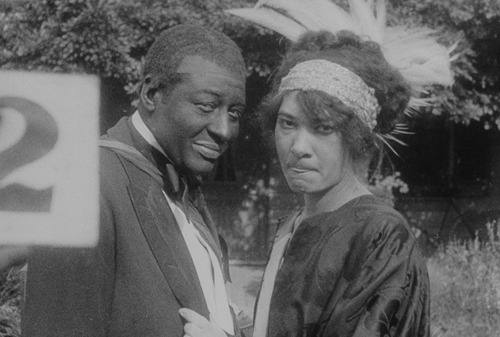
2. Bert Williams: “Brother Low Down”
As a new generation, the jazz generation represented here by Sissle and Blake, dawns, the previous generation, powered by ragtime, vaudeville patter, and Coon song, sets. Bert Williams, here from the beginning, bows off with this mordant character sketch of an itinerant street preacher begging for booze money and defensive about his preaching permit. It’s Coonery, in the generic sense of presenting a caricature of blackness for the amusement of whites, but it’s also part of a long Black (and Jewish) tradition satirizing religious hypocrisy and celebrating idiosyncratic locutions. Williams collapsed on stage in February 1922, his final public act being to raise a laugh from an unfeeling audience believing it was part of the show. Which as a metaphor for his career, and the entire century, is hard to better: Black suffering as just another disposable consumer product, entertainment to the end.

3. Ethel Waters: “There’ll Be Some Changes Made”
With a song pitched at the exact midpoint between Sissle and Blake’s middle-class reverie and Williams’ working-class satire, we meet one of the century’s legendary figures, one of the peerless voices of the jazz-song revolution already underway. Written by overlooked Black composer Benton Overstreet and underappreciated Black comedian Billy Higgins (both retrospectively pointed out by Langston Hughes as masters in their field), “There’ll Be Some Changes Made” lifts a line from “Crazy Blues” to produce a more overtly comic song about putting oneself back together after being walked out on by a no-good man. Waters’ sweet-and-sour voice neither overplays the comedy nor makes a blues tragedy of the material: one of the first great recordings of the Harlem Renaissance, its clear-eyedness and good humor about sexual relations between consenting adults makes yet another subject on which Black America reluctantly instructed its white counterpart.
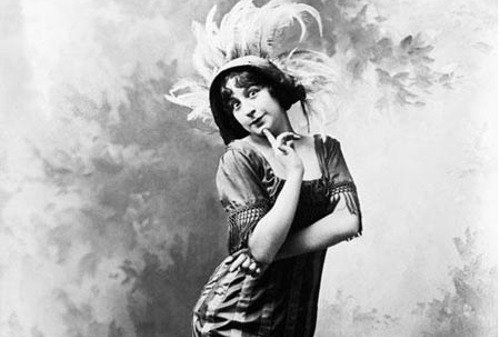
4. Fanny Brice: “Second Hand Rose”
The B side of Victor 45263 would in time prove to be one of the most influential recordings in US musical history, arguably inventing the torch song as a genre, but we met “Mon homme” last year on the continent where it was even more influential. Anyway the A side, “Second Hand Rose,” is far truer to Fanny Brice’s stage persona: a nice but impoverished Jewish goil whose ignorance, forthrightness, and pretensions are played for laughs — but crucially, the laughs came not only from the presumed upper-crust WASP theater audience, but from her fellow immigrants. The rubber-faced, nervily dynamic performer born Fania Borach had headlined the Follies in 1910, when she was just nineteen; ten years later she was back with Ziegfeld and bigger than ever. Jolson and Cantor got better publicity, but of that generation of Jewish-American stars, she was the genius.
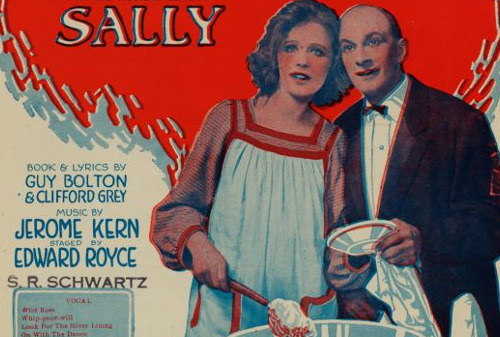
5. Marion Harris: “Look for the Silver Lining”
Three years on from the Great War, only one of the Powers was experiencing an economic boom. Americans have traditionally been optimists anyway, but the psychological moment was even more ripe for popular songs expounding on the tenets of the New Thought, a philosophical charlatanry whose descendants include the Power of Positive Thinking and the Secret. Even Al Jolson making a bid as the Apostle of Pep with “April Showers” wasn’t as complete a victory for the sunny-side-up brigade as the smash hit from Sally, the Jerome Kern musical which inaugurated the Flapper decade almost as neatly as Shuffle Along inaugurated the Harlem same. The lyric for “Look for the Silver Lining” functions beautifully in the show as the plucky title character’s never-say-die philosophy, but it’s that swoony Kern melody which has made it immortal, long after every silver lining has rusted over.
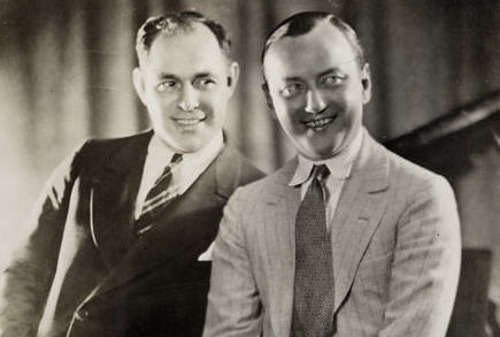
6. Van & Schenck: “Ain’t We Got Fun?”
A more cynical philosophy, if one just as indelibly associated with the new decade, is expressed here, in our first encounter with Tin Pan Alley composer Richard A. Whiting, whose career will cross our paths many times more. His skip-a-doodle melody ensured the song a long life in newsboy’s whistles, but it’s Gus Kahn’s witty, slangy lyric, highlighting the contrast between the jet-setting lifestyle promised in magazine advertisements and the actual poverty experienced by millions in a time of ever-sharper inequality, that made the tune so characteristic of its era that it’s been quoted everywhere from Gatsby to Zelig. The vaudeville harmonists Gus Van (baritone) and Joe Schenck (countertenor), Americans of German stock who happily embraced Irish, Italian, or Jewish stereotypes depending on the routine, had the hit record, and their beefy, down-the-middle rendition sells both the title’s cheerfulness and the verses’ shrug.

7. Sam Moore: “Laughing Rag”
As jazz became, seemingly overnight, the newest sensation in popular music, its forefather ragtime, freed from the burden of being the most advanced thing going, continued to mutate. This record, essential to any history of jazz or even country music, takes the Hawai'ian slack-key technique (though on the Octo-Chord, a custom-built eight-string guitar) and applies it to ragtime proper, approaching jazz at one end and predicting Nashville steel pedal workouts for generations to come at the other. His protegé Roy Smeck’s 1928 cover of “Laughing Rag” is canonical in Grand Ole Opry lore, but it is Virginia-born vaudevillian, eccentric, and (briefly) Follies star Sam Moore who sits at the crossroads of Hawai'ian and country music, and his ragtime will, as we will see, spread kudzu-like through the broad highways and quiet backwaters which make up all the musical permutations of the American South.
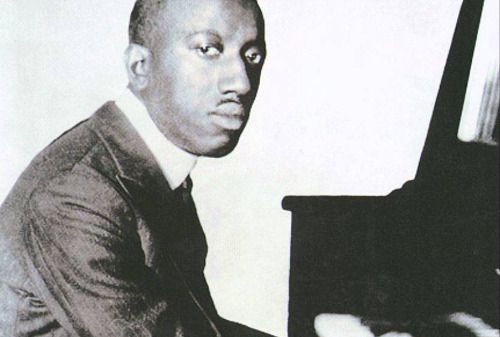
8. James P. Johnson: “Keep Off the Grass”
Another, and perhaps more consequential, mutation of ragtime was the strain developed by piano hustlers at Harlem rent parties, hired hands to make the joint bounce so the hosts could make rent, a strain which only made its way onto record in 1921. New Jersey native James P. Johnson was the acknowledged master of the new “stride” piano style, so named because of the distance the hands traveled in order to maintain the rock-solid rhythm and harmonic filigree. Comparison to the popular piano novelty of the day, “Kitten on the Keys,” is instructive: Johnson’s composition has a real low end, a greater chromatic range, and an ass-shaking drive. Where “Kitten” simpers, “Grass” slams, which is why stride looks forward to boogie-woogie and thence to rock & roll, and thus gains a measure of eternity. Novelty lives for a day; Black American jazz is forever.

9. Johnnie Dunn’s Original Jazz Hounds acc. Edith Wilson: “Nervous Blues”
The “Crazy Blues” blues craze continues apace; this overview, attempting to look in dozens of directions at once, can only skim the surface. Edith Wilson was an another all-around singer rather than a blues singer strictly speaking, and had only been professional for two years when she found herself swept up in Columbia’s dragnet. With Wilson singing a Perry Bradford composition for Johnnie Dunn, who had led Mamie Smith’s band, “Nervous Blues” is as straight a sequel to “Crazy Blues” as anything, including Mamie’s own voluminous output. The subject was in the zeitgeist anyway — popularizations of Freud claimed nerves as the trouble of the age, and nervous disorders were, along with urbanization and Jewishness, diagnosed as one of the three scourges of traditional values by reactionaries everywhere, including Hitler; in which climate, there’s something heroic about a Black woman owning her mental health.

10. Gertrude Saunders: “I’m Craving for That Kind of Love”
Edith Wilson’s primary claim to fame in the later 1920s would be her showcases in revues built around Florence Mills, the startling comet of Black excellence in music, dance and comedy who flashed so briefly across the Harlem Renaissance that she never recorded; but she will haunt these pages. Florence was catapulted to fame as a replacement for the soubrette role in Shuffle Along; the woman she replaced was Gertrude Saunders, whose most legendary achievement in later years was getting cold-cocked by Bessie Smith over a man; but here, singing the song that Florence would make her own within a year, she whoops and hollers, turning Sissle and Blake’s original tune almost unrecognizable in her performance of salacious, wild-child desire. It’s the sort of gleefully unhinged performance that would come to be associated with punk rock, and it’s all we have of her.
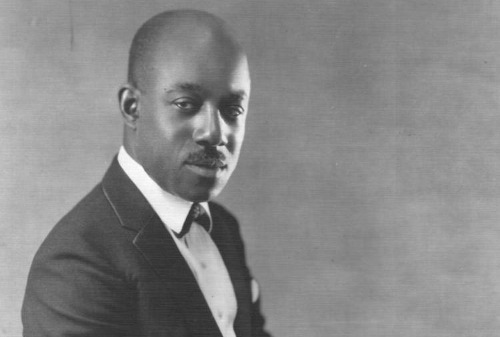
11. Eubie Blake: “Sounds of Africa”
As epochal as Shuffle Along was, it was not the only, or perhaps even the greatest, achievement of its composer in the year of his glory. “Sounds of Africa,” its title usually changed to “Charleston Rag” in later publication form, is one of the deathless piano solos of a decade in which the piano solo recording became an art form to itself. Blake’s heterogenous musical apprenticeship had included years playing for the high rollers in Atlantic City, one of the liminal spaces where white people consumed Black bodies, services, and art without making much distinction between them; generally unaware that those Black bodies were doing just as much consuming. “Sounds of Africa” features both a funky walking bassline and Debussy-like chromaticism, and it is ragtime pushing not just into furious, hard-rocking modernism, but into regions of pure sound. That you can dance to.

12. Carlos Gardel: “La copa del olvido”
Tango and jazz were experiencing simultaneous early golden ages in 1921, but the dynamics of the musics’ dissemination were quite different. Shuffle Along was a landmark theatrical event, the first jazz musical; meanwhile, Cuando un pobre se divierte, the play from which “La copa del olvido” became working-class dramatist and lyricist Alberto Vaccarezza’s first hit song, was only another of the hundreds of sainetes criollos, in which tango songs were de rigeur, being produced in Buenos Aires in those years. Gardel, the by now irreplaceable voice of tango, recording the song — and Enrique Delfino, who has appeared here frequently as a composer, providing the music — was a greater imprimatur than the show. Although neither Gardel’s tremulous performance nor Delfino’s sketchy melody make the song immortal: that’s the lyric, in which the singer calls for another round while he contemplates murdering his faithless lover.

13. Grupo do Moringa: “No rancho”
The vast majority of our visits to Brazil have been to Rio de Janeiro, where the port-town outbreaks of miscegenation, musical and otherwise, allowed such epochal musical traditions as the samba to flourish. But Brazil has always been much larger and more diverse than that; as one hint of which, over to composer Eduardo Souto, born in Rio but who consciously worked in all of the established Brazilian (and some foreign) musical fields. “No rancho” (in the countryside) is designated as a cateretê, by legend an ancient folkloric Amerindian dance, revived by São Paulo cosmopolites like vanguardist poet and novelist Mário de Andrade, who considered it one of the few authentic Brazilian traditions. Souto’s melodic and rhythmic sense, though, is anything but ancient, and such representations of countrified subaltern traditions given national mythological meaning by sophisticated urban tastemakers was hardly limited to Brazil.

14. Georgel: “La vipère”
Vincent Scotto, the great twentieth-century composer of French chanson réaliste, is by now a regular in these pages, but the interpreter is new to us, though in 1921 he was well-known to Parisian audiences. His pompadour and mincing stage manner was borrowed (with blessings) from Félix Mayol, and his choice of repertoire owed something to music-hall legend Harry Fragson, but between the wars Georgel far outstripped his old masters as one of the key voices of les années folles. “La vipère” is about one of Scotto’s (and popular culture’s) standbys, the female viper, who tempts the young man away from work, home, and family, to keep him in misery while she sells her body. He gets his revenge in the final verse in classic Grand Guignol fashion, but the gruesome narrative isn’t really the point: Georgel’s half-sobbing, half-humorous delivery exemplifies the (French) decade.

15. Orchester mit Refraingesang: “Das Lila Lied”
A landmark in queer media, “Das Lila Lied” (the lilac song) was very likely the first gay anthem in Western popular music. Deviance, sexual and otherwise, had long been a subject of chanson, but lyricist Kurt Schwabach and composer Mischa Spoliansky — two Jews working in Berlin’s legendary queer-friendly kabarett scene — dedicated their lied to Magnus Hirschfeld, the researcher whose Institute for Sexual Science was the first organization in the Western world to advocate for the rights of homosexual and transgender citizens. The chorus, which begins and ends “We are different from the others,” is as much protest song as sentimental education, the way pop usually works; but although the Weimar Republic officially protected homosexuality, it was still so taboo that Spoliansky used a pen name, and as far as I can ascertain, the players and singer of this, the first recording, remain uncredited.
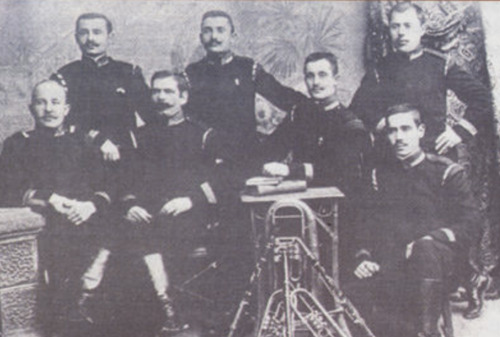
16. Kandel’s Orchestra: “A Zoi Feift Min Un a Schweiger”
By 1921, the most modern and up-to-date form of popular music was the dance band, playing uptempo, lightly syncopated but not actually jazzy music with orchestral instruments. Paul Whiteman was the clear leader, but there were similar outfits in every city in the nation, and much of the rest of the world. Which was nothing new to the Eastern Europe-born klezmorim of New York, who had been working in similarly-sized outfits, and often at much faster tempos, for decades without being embraced by uptown goyim hotel dancefloors. Clarinetist Harry Kandel, born in the Ukraine, was one of the great klezmer bandleaders of the era, and on this recording, “Putting it Over on Mother in Law,” he pushes his orchestra to such whirling, piercing heights, with the drummer knocking regular off-beats, that together they predict not only swing, but even elements of free jazz.
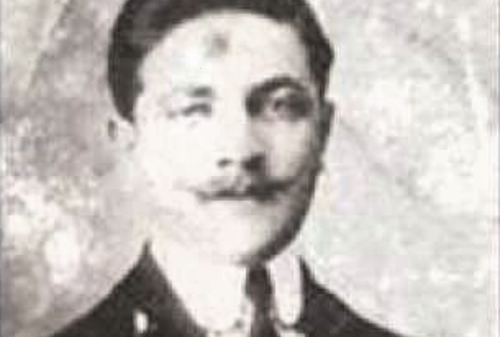
17. Achilleas Poulos: “Kamomatou”
Relatively little is known about proto-rebetiko singer Achilleas Poulos, save that he was born in the northwestern Balıkesir province of Turkey (then the Ottoman Empire), and emigrated to the United States in 1913. His powerful voice and wide repertoire made him a briefly popular recording artist in the Ottoman-Greek diasporic community, recording for just ten years before falling silent until his death in 1970. In this early recording, issued by an independent Armenian label in New York, the stark instrumentation (Poulos himself played the oud) creates a surprisingly modern backdrop for his arresting, emotional voice as he sings a lament of unrequited love, full of ancient, stark imagery like flames, clouds, and darkness. “Kamomatou” (lit. mischief-maker) can be translated as coquette or temptress, a woman who makes hay of men, and it’s been used frequently as a title in twentieth-century Greek songs.
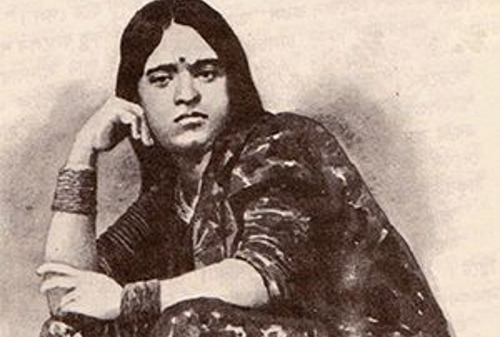
18. Miss Indubala: “Ore Majhi Tori Hetha”
It’s virtually impossible to fit most Asian recording activity into the models I’ve been building of emergent Western popular musics; this recording by a young woman who would, a decade later, become one of the early stars of Bollywood, both on screen and in playback recording, was not so much a remarkable record in its moment as it is a historical marker, a signpost on the road to emergent modernism. The droning backdrop of the harmonium, introduced to the subcontinent by Victorian colonizers and still despised by classical purists in the early 20th century, is one element of modernity: another is the parenthetical (Jangla) on the label, indicating that the performance is a combination of two or more traditional ragas. The third is Indubala Devi herself, trained in the vanishing courtesan-singer tradition of Kolkata, granting herself immortality by saying her name on record.
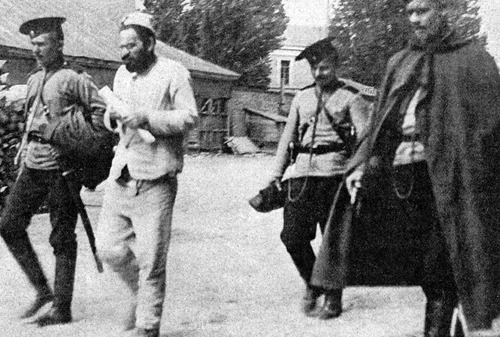
19. Jacob Gegna: “A Tfileh Fun Mendel Beilis”
In 1911, the body of a young boy was found mutilated on the outskirts of Kiev. Authorities arrested a local factory superintendent on suspicion of his having murdered the child in a secret Jewish blood ritual. After Mendel Beilis insisted on clearing his name, refusing a general clemency for convicted felons, his trial was one of the sensations of the late Tsarist era. The most infamous blood libel of the twentieth century swept up honest investigators and reporters who were threatened with dismissal or worse for defending the innocent man; Beilis was finally acquitted after two years of a horrific media circus, followed particularly closely by the millions of Jewish immigrants in the United States. Jacob Gegna, a violinist who had himself immigrated from the Ukraine the following year, cut a single record in 1921, including this moving tribute to the innocent Beilis.

20. Michael Coleman: “The Shaskeen”
Traditional Irish music has rarely taken up much space in these pages, and will continue to do so; my emphasis on novelty, hybridity, and pop ethics over tradition, purity, and folk ethics means that there’s rarely much space for purely local traditions, no matter how sentimentally widespread. Still, I have two ears and a heart. Probably the most influential traditional Irish musician of the twentieth century, Michael Coleman was a remarkable exponent of the Sligo fiddle tradition, playing fast-paced, polyphonic reels that allow him and his piano accompanist to sound like a full band. “The Shaskeen” was one of his first records, a corruption of the Irish seisgeann or marshland, and its sheer velocity makes plain the hypothesis that American vernacular music gets its funk from its African heritage and its recklessness from its Irish. And in December 1921, Ireland was free.

21. Antonio and Luigi Russolo: “Corale”
Eight years after Luigi Russolo’s landmark Futurist manifesto L’arte dei Rumori, in which he theorized an industrial, electronic “art of noises” that would come to replace the limited sonic palette of the traditional orchestra, a solitary 10-inch record was issued which combines his brother Antonio’s conventional orchestral pomp with the roar and howl of the Intonarumori, acoustic instruments of Luigi’s design that produced atonal snarls of noise by vibrating strings at different frequencies, amplified by a drum. It is an explosion of the avant-garde into the safe commercial marketplace of the recording industry, and it was followed by years -- even decades -- of silence. It will not be for another thirty years that further experiments in using pure noise as music become commonplace, by which time the whole structure of recording will have been transformed. But here in the 21st century, Russolo was right.
19 notes
·
View notes
Photo


Hii ☺
So this weekend was all about work, since exams, oral apresentations. tests and so on...These girls are my classmates, best friends and together we have a band where we all sing Disney songs from the early XXI century, instead of actually doing our Geography work.
@pinkmotivation can confirme how good singers we are and what a great harmony we make.
6 notes
·
View notes
Audio
TRACKLIST
- Kevin Aviance - Fanfare
1st track of his album Box of Chocolate. Kevin Aviance is a queer american icon, member of the voguing House of Aviance.
- Kevin Aviance - Dance for Me
Another track from the same album, less known than the voguing bangers Cunty or Din Da Da.
- Robert Owens - Ordinary People (Robert's Original Vibe)
Essential vocalist of the Chicago scene and an active DJ in gay clubs for decades.
- Garrett David - Clap Ya Hands
The DJ and producer made this track in hommage to his gay residency The Queen! at Smart Bar Chicago
- Quentin Harris & Ultra Naté -Give it 2 U (Azari & III remix)
Quentin Harris is a gay producer from New York. The track was remixed by former canadian band Azari & III : Dinamo Azari, Alixander III, Starving Yet Full & Fritz Helder.
- Honey Dijon - Look Ahead feat. Tim K feat. Sam Sparro (Horse Meat Disco's Vauxhall Version)
It's a meeting of LGBTQ+ icons here ! Proud trans DJ Honey Dijon teams up with australian singer Sam Sparro, remixed by the london crew and party organizers HMD.
- The Carry Nation - Still on the line (part 1)
The duo Will Automatic and Nita Aviance is heavily active on the underground NYC gay scene and now resident at Brooklyn's Good Room.
- Catz' n'Dogz - One Plus You feat. Kiddy Smile & Rouge Mary
French artists Kiddy Smile & Rouge Mary are leaders of the parisian nightlife: Kiddy as a DJ, producer and member of the voguing house of Mizrahi, Rouge Mary as trigender vocalist.
- Massimiliano Pagliara - MS20-707-M/P-P6-SPX90
Italian icon of the Berlin club scene and a regular of international gay clubs and festivals.
- RuPaul - WorkOut (Junior's Club Dub)
Well, who needs to introduce the drag queen Rupaul, here remixed by the club legend Junior Vasquez, long time closed collaborator of the House of Xtravaganza.
- Eris Drew - See You In Snow
Trans DJ founder of the polysexual parties Hugo Ball and of the label T4T LUVE NRG with her partner Octo Octa.
- Shaun J. Wright, Alinka - Matters Of The Heart (The Black Madonna Remix)
Both Shaun J. Wright and Alinka are the founders of Twirl parties and label. The Black Madonna joins them on the remix, making it gay-er than never.
- Club 69 & Kim Cooper - Let Me Be Your Underwear (Underground Club Mix)
One of many monikers of Peter Rauhofer, austrian DJ, know for his gay residency at Roxy club (NYC), his pop remixes and his sets at circuit parties.
- Octo Octa - Spin girl, let's activate !
Breakbeat and house DJ, partner of Eris Drew. What a producer <3
- Hannah Holland - Diva Bern, Pt. 1
Hannah Holland has played a pivotal role in London’s alternative and queer London club scene since the mid-noughties, including though her label and party Batty Bass
- Kim Ann Foxman - E4 Energy
Acid producer Kim Ann Foxman is also known for being part of the queerest band ever : Hercules & Love Affair.
- Andrew Butler, Jason Kendig - Give It To Me (Snuff Crew Remix)
Andrew Butler is the founder of Hercules & Love Affair. Jason Kendig is a member of american 4-members gay collective Honey Soundsystem.
- Discodromo - Build A House feat. Hard Ton (Prins Thomas Edit)
Italian duo mostly known for their label and infamous Berlin party CockTail d’Amore. Hard Ton on the vocals here, who claims to be the biggest disco queen of the XXI Century :)
- The Coming Out Crew - Free, Gay and Happy (Deep Throat Vocal)
Isn't it the best gay track ever ?
- Frankie Knuckles feat. Jamie Principle - Baby Wants to Ride (Re-Directed)
Simply the Godfather of house music. He is now inducted into the Chicago Gay and Lesbian Hall of Fame. And what a sexy track to end this mix !
Artwork by Maxime Mondet
0 notes
Text
Hey ya!, The best song of the XXI century?
When I was little my dad had a huge collection of cd’s which contained a lot of music videos. In one of those cd’s it was the music video “Hey ya!” by Outkast and I was obsessed with it. I remember thinking that the song was so much fun and I loved the fact that the singer was multiplied into the whole band in the video. If you saw the music video you know what I’m talking about but if you didn´t, the video is about Andre 3000, the performer and member of Outkast, dancing to the song in a green shirt and a green and white background. In the video he interpreted not only the singer but he plays the synth, the drums, the guitar and he does the voices of the choir.
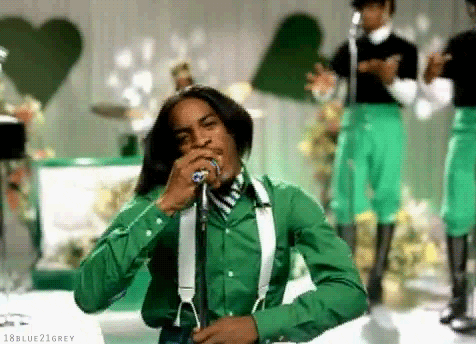
The song was released on september 23th, 2003 and it made a huge impact in the music industry winning a grammy for Best Urban/Alternative Performance and being placed in the number 3 of the 100 best songs of the century list made by the magazine the Rolling stones.
The song written by Andre for the album Speakerboxxx/The Love Below along with his partner Big Boy sounds like a mix of different genres, being influenced from bands like the Ramones and The Smiths in the acoustic guitar, introducing the synthesizers in the choruses making kind of like a pop vibe, lyrics being recognized as hip hop and lastly a chorus influenced by soul and even gospel.
But even if the Melody of the song has a really joyful vibe, the lyrics of the song says a whole different thing. It speaks about a couple who are not happy in the relationship and cannot stand each other, but they are in denial and keep trying to stay together.
The video doesn’t have a huge production or has a history behind it but I think that the personality of Andre and the way he dance is so silliness as he gives different styles to every musician. On the other hand, the art direction did a really good job focusing on the palette of color of the video especially when it’s really simple but unique and it makes it easy to recognize. Also the video makes reference to the show “The Beatles” in The Ed Sullivan Show.
Even though it is a debate to call it the best song of the history when even Andre isn’t that sure, it’s a really good song and fun video that I love and invite all of you to watch.
Favianna Salinas
0 notes
Text
And They Played Shang-A-Lang tells the story of growing up in 70s Edinburgh. Through laughter, tears and 70s hit music, we negotiate the stormy waters of adolescence.
SUPERCALIFRAGILISTICO – El Musical. One of the best children’s musical of recent times This show is a tribute to Mary Poppins in the XXI century on 28th March starting 6:30p.m. at Paraninfo ULL Numerado Central Building University of La Laguna.
The Kanka returns to Tenerife and this time he does not come alone, as he will be accompanied by his band at 9:00pm on 28th and 29th at Aguere Cultural Space, La Laguna
Sensaciones más que Mar is celebrated in Los Abrigos, on March 29, between 18.00 and 24.00. As usual, there will be a range of stands, displays, music and seafood tapas.
“SHOSTAKOVICH” The concert and the symphony were written in the middle of World War II. Transporting the listener to classical cinema. The symphony speaks of the “shock” of the unexpected pact between Stalin and Hitler in 1939. 7.30pm on March 29 at Adán Martín Auditorium, Santa Cruz Price: From €17. Tickets here.
Vicente Rey returns to his homeland at the end of his South American tour to celebrate his 40 years career, a concert for an exclusive audience at 20:30 on 29th at Teatro Guimerá Plaza Isla timber, Santa Cruz.
The Ezza trio composes original music, influenced by blues, rock and traditional Tuareg songs that glance at their culture, the situation of their country and the future of the Tuareg population. 29th March 20:00 Cultural space CajaCanarias, Santa Cruz
“Live the Rock, The Concert”. The objective is to promote amateur bands who play rock, hard rock, heavy metal and AOR sound; offering them a space in which to make themselves known. First Session takes place on 29th March at 10:00pm Sala Arcon Puerto de la Cruz.
Concert 1st and 2nd Cycle of the Professional Music Conservatory of Santa Cruz 29th March at 7:30 p.m. ULL Paraninfo Central Building University of La Laguna tickets www.tomaticket.es
“Little Mermaid – The Musical” a great show for the whole family. Wonderful costumes and popular characters join to the rhythm of great musical numbers that go from pop to soul and will create unforgettable moments 30th and 31st at Teatro Guimerá. Tickets from €15. Tickets here.
30th at 23:59 Lunay Considered one of the most talented of the new generation of singers of urban genre. Prepare for what is coming. Marinha Beach disco club (Adults only)
Great Musical Gala – Condensed in two acts, this is a spectacle of joy and fantasy from children’s stories. 30th March, Teatro Principe Felipe, Tegueste
The V Fuentealta Vilaflor Trail arrives on 31st March full of novelties. 20 km in pairs, 40 km in pairs and 40 km relay. And the already traditional 12 km, 20 km, 30 km and Marathon Trail
31st March Carmen at 7:30 p.m. ULL paraninfo, Central Building University of La Laguna tickets www.tomaticket.es
CONCERT: “THOMAS OSPITAL” Repertoire: “Ma mère l’oye, Cinq pièces enfantines (Transcription Thomas Ospital)”; “Prelude and escape on the name Dealain (12 ‘)”; and “Third Symphony, OP. 28 (35 ‘) ” March 31 at Adán Martín Auditorium, Santa Cruz at 12:00 Price from €7.50.Tickets here
For more info on Tenerife read the Red Queen Musings everyone’s favourite Tenerife Blog
Upcoming Entertainment for the week ahead And They Played Shang-A-Lang tells the story of growing up in 70s Edinburgh. Through laughter, tears and 70s hit music, we negotiate the stormy waters of adolescence.
0 notes